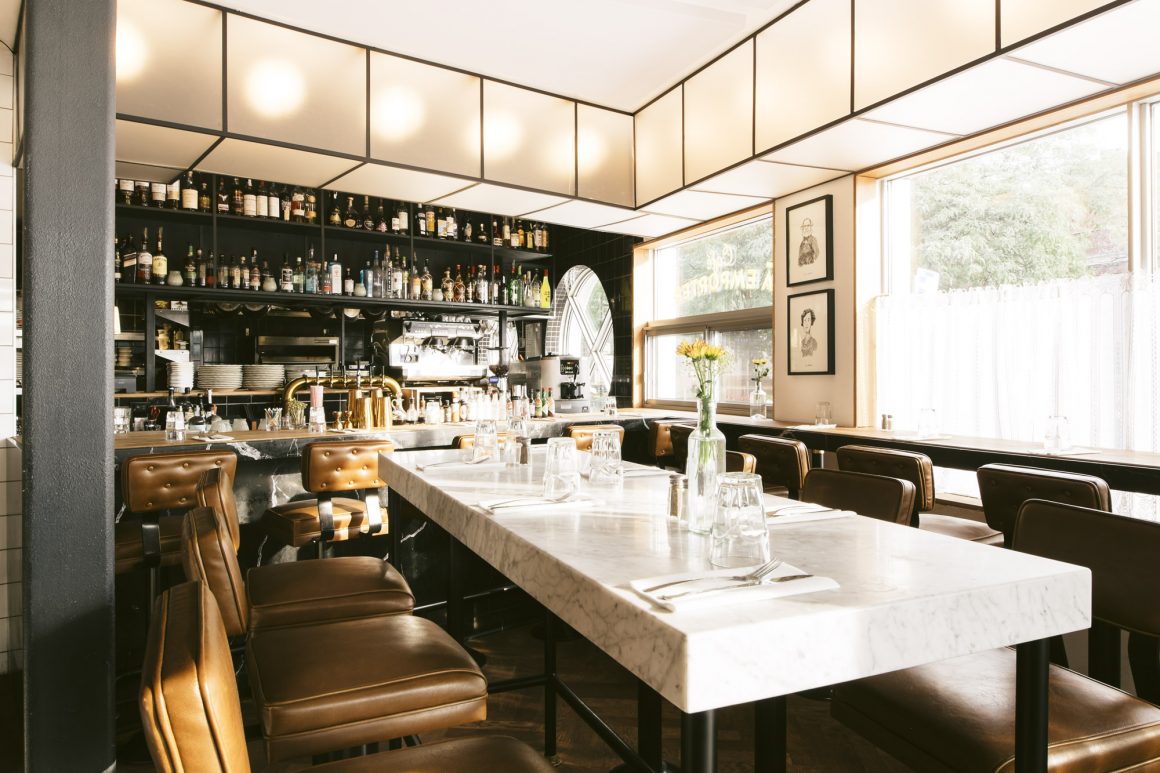
Connecting customers with the creative workings in the kitchen: That is one of the themes in today’s restaurant design. Gone are the days when chefs toiled behind doors that would swing open and closed as the wait staff scurried back and forth, forging a detached link between cook and customer. The modern dining experience is a much more intimate affair. The trendiest restaurants today not only provide their guests with a table in a highly designed setting, but also offer a spot from which to watch the culinary creations come to life.

Being on-trend means immersing guests in the complete dining experience.
Let’s take a look at how some of today’s avant-garde eating establishments blend form and function, providing a full menu for all the senses.
Figo
Figo is a perfect example of the new wave in restaurant design. Located in the heart of Toronto’s downtown core, it offers romantic Italian dining. The 4,200-square-foot establishment was conceived by Toronto’s award-winning Studio Munge.

Among its most spectacular features is the graphic archway between the dining area and open kitchen. Made of 4,000 hand-placed tiles, the archway perfectly frames the action in the kitchen, allowing diners to watch as their artisanal dishes are created, as if they were viewing a live stage production.

The ceiling above the dining area at Figo also helps set the tone. Featuring a large custom floral application in light shimmering pastels, the surface above the entire seating area, adds a touch of romance and charm, creating the impression that visitors are dining in a country village in Italy.

The cathedral-style wine cabinet in the bar-lounge catches the eye, as well, contributing to the Old-World sophistication that permeates the space, while the curved custom-made glass tables and white marble bar provide a contemporary touch.
Hoogan et Beaufort
Hoogan et Beaufort is an upscale restaurant in Montreal’s Rosemont borough. Housed in a building that once served as a train-manufacturing facility in the former CPR Angus Shops, it has 28-foot ceilings and 2,700 square feet of space. It strikes a balance between contemporary and traditional styles, with an industrial vibe.

Designed by the Montreal-based APPAREIL Architecture, the restaurant pays homage to its industrial past. In fact, its name, Hoogan et Beaufort, honours the two farmers who originally owned the land that was purchased to create the CPR Angus Shops in the late 1800s.

The old wooden beams in the ceiling, along with custom-made refurbished finishings provide an unpretentious feel, while the open-flame kiln-like oven on full display provides an enchanting rustic charm.
Kōst at Bisha
Kōst is a rooftop restaurant that sits atop the Bisha Hotel in Toronto’s entertainment district. Its use of white Canadian oak gives the entire space a beach-house ambience.

Wooden trellises clad the surface of the ceiling, while the use of the light-coloured wood extends to the walls, beams and tables. The look reflects the openness of the high-rise location.

The restaurant, designed by Studio Munge, features custom seating, including oak bar stools with apricot-coloured velvet upholstery, woven rattan chairs, and banquettes finished in ivory and orange, while the light oak tables feature interlocking tile insets. The look is light and airy, while the layout allows guests to take in views of the city’s skyline as well as the action behind the bar or in the kitchen, visible just beyond a marble counter in peach, seafoam-green, and cream tones.
Foiegwa
The open-kitchen concept is also at the centre of the hip new Montreal restaurant Foiegwa. This self-described “Americanized French diner” takes its name from the American pronunciation of “foie gras.”

Designed by the gauleybrothers, the restaurant is located in a former Belle Province fast food outlet at the corner of Atwater Avenue and Notre Dame Street in the city’s St. Henri district.

The open kitchen is framed by white tiled walls that are filled with sketches by local artist Marc Tremblay. The framed drawings are of famous Montrealers, much along the same line as those seen in the iconic New York City diner Sardi’s.

In addition to the open kitchen, the use of wood and black marble imparts an upscale look. Although used sparingly, the natural wood accents frame the tile walls and coordinate with the tan-coloured banquettes and upholstered stool chairs.
Le Super Qualité
Although considered a diner in every sense of the term, Le Super Qualité in Montreal’s Villeray district is on trend with its look that includes a view of the kitchen and the use of wood.

Designed by architect David Dworkind, this Indian snack bar draws inspiration for its style from a few sources. The bright-blue-and-yellow colour scheme is taken from the palette used on Indian commuter trains. Rough plank cladding in a blue-painted finish is also used along the base of the counters.

Wood is prominently used in the seating area, where the bright colours are balanced by the natural wood tabletops, while stainless-steel countertops and accents, such as custom lighting pendants, match the gleaming surfaces in the open kitchen. •

Figo Toronto
295 Adelaide St. W, Toronto
647-748-3446
www.figotoronto.com
Hoogan et Beaufort
4095 Molson St., Montreal
514-903-1233
www.hooganetbeaufort.com
Kōst
80 Blue Jays Way, 44th Floor, Toronto
437-800-5938
www.kosttoronto.com
Foiegwa
3001 Notre Dame St. W., Montreal
438-387-4252
www.foiegwa.com
Le Super Qualité
1211 Rue Bélanger, Montreal
514-398-0184
www.lesuperqualite.com








